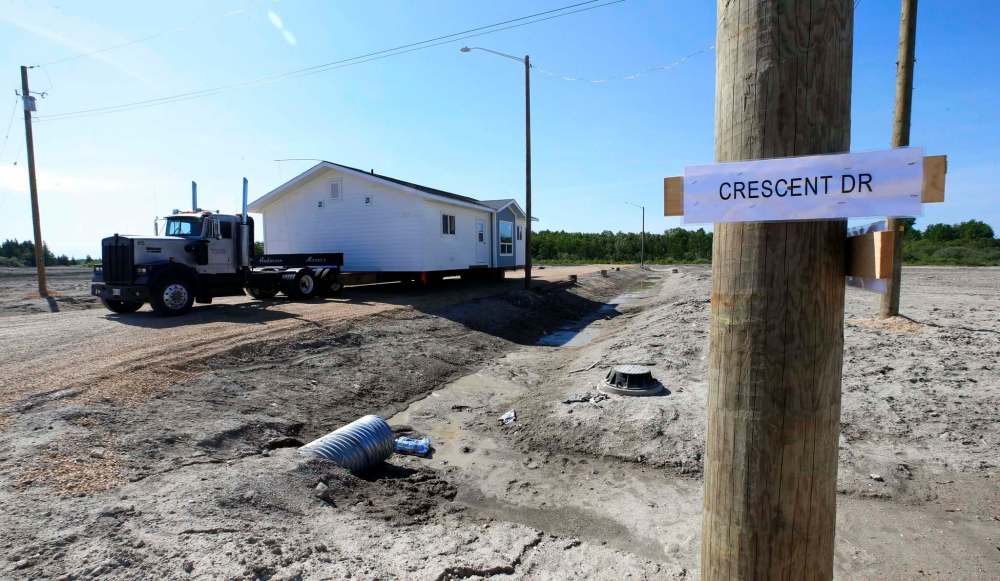Lake St. Martin gets closer to home
Flood-displaced First Nation residents returning to new houses
Advertisement
Read this article for free:
or
Already have an account? Log in here »
To continue reading, please subscribe:
Monthly Digital Subscription
$0 for the first 4 weeks*
- Enjoy unlimited reading on winnipegfreepress.com
- Read the E-Edition, our digital replica newspaper
- Access News Break, our award-winning app
- Play interactive puzzles
*No charge for 4 weeks then price increases to the regular rate of $19.00 plus GST every four weeks. Offer available to new and qualified returning subscribers only. Cancel any time.
Monthly Digital Subscription
$4.75/week*
- Enjoy unlimited reading on winnipegfreepress.com
- Read the E-Edition, our digital replica newspaper
- Access News Break, our award-winning app
- Play interactive puzzles
*Billed as $19 plus GST every four weeks. Cancel any time.
To continue reading, please subscribe:
Add Free Press access to your Brandon Sun subscription for only an additional
$1 for the first 4 weeks*
*Your next subscription payment will increase by $1.00 and you will be charged $16.99 plus GST for four weeks. After four weeks, your payment will increase to $23.99 plus GST every four weeks.
Read unlimited articles for free today:
or
Already have an account? Log in here »
Hey there, time traveller!
This article was published 25/08/2018 (2666 days ago), so information in it may no longer be current.
Federal and provincial levels of government marked the completion Friday of 190 homes on new reserve lands for Lake St. Martin First Nation.
The statement posted online by federal Indigenous Services applauded Lake St. Martin for its patience in working with both levels of government over seven years of displacement.
“Members of Lake St. Martin have demonstrated remarkable strength and resiliency in their efforts to rebuild their community following the devastating flood of 2011,” Indigenous Services Minister Jane Philpott said in the statement.

In addition to the new homes (which had been under construction for the past year), the statement noted Manitoba and the federal government worked together to cost-share a $49.5-million rebuilding project that included vital infrastructure for new reserve location on higher ground, next to the reserve land that had been inundated.
It includes a public works garage, a fire hall, water and sewage treatment facilities. Ottawa provided $19.7 million for the construction of a new K-12 school that should be open in time for its first classes in September.
“Thanks to a lot of hard work and collaboration over this past year, flood evacuees have begun to return to their home community. We will continue to work positively and respectfully with the First Nations to ensure the safe return home of flood-affected community members,” said Eileen Clarke, the province’s minister of Indigenous and northern relations.
In 2011, a devastating flood displaced four Interlake First Nations, swamped farmland, ruined cottages and businesses and cost government hundreds of millions of dollars in compensation programs.
Lake St. Martin, located 255 kilometres north of Winnipeg, was hardest hit. Hydro and electricity were cut off and families were sent to Winnipeg, spending months in hotels before being moved to rental housing.
The work with the two levels of government took place alongside related legal developments that have been all but settled in the intervening years.
In January, a judge approved a $90-million compensation settlement to resolve a class-action lawsuit filed by members of Lake St. Martin and its neighbours from Pinaymootang, Little Saskatchewan and Dauphin River First Nations.
As of this spring, 284 individuals, or 155 households, had moved into the new homes. Work continues on another 130 homes to be completed by November 2019.
In the statement, Lake St. Martin Chief Adrian Sinclair referred to the multi-year effort as “Operation Return Home.”
“Our people have been through so much in the past seven years. It’s comforting to know some of our members have returned home. However, we still have over 300 people who want to return to our traditional lands. Much work, negotiations and planning must be done to see the next wave return home in the fall of 2019,” Sinclair said.
He could not be reached for further comment Friday.
As of June, 1,700 evacuees from the 2011 flood had yet to return home, including 1,000 from Lake St. Martin.
alexandra.paul@freepress.mb.ca





